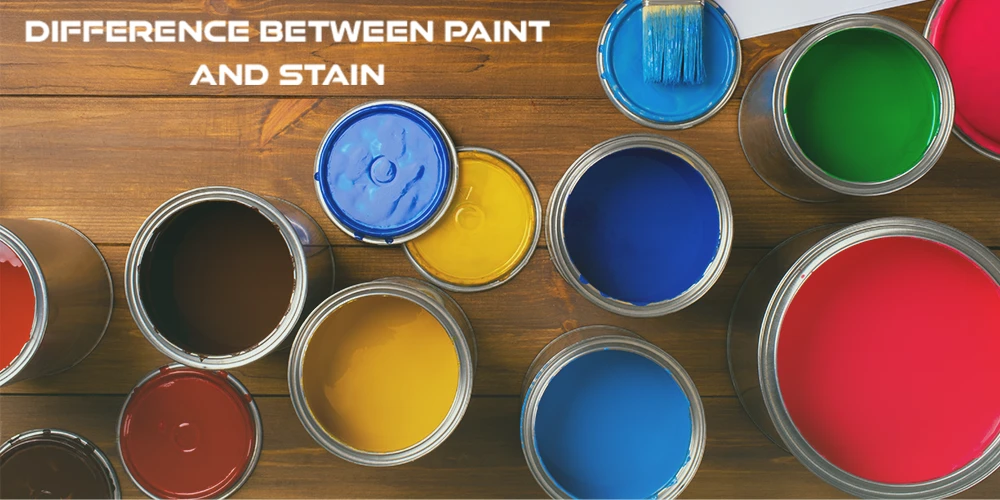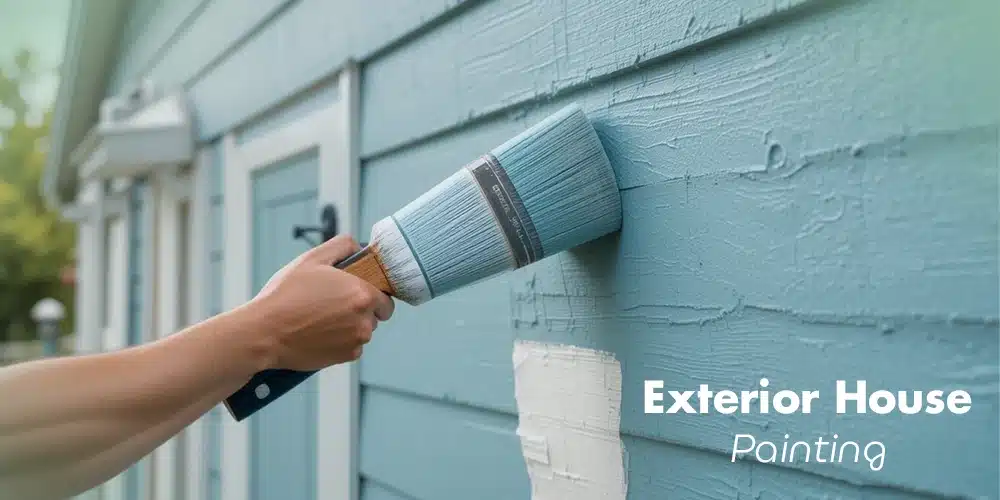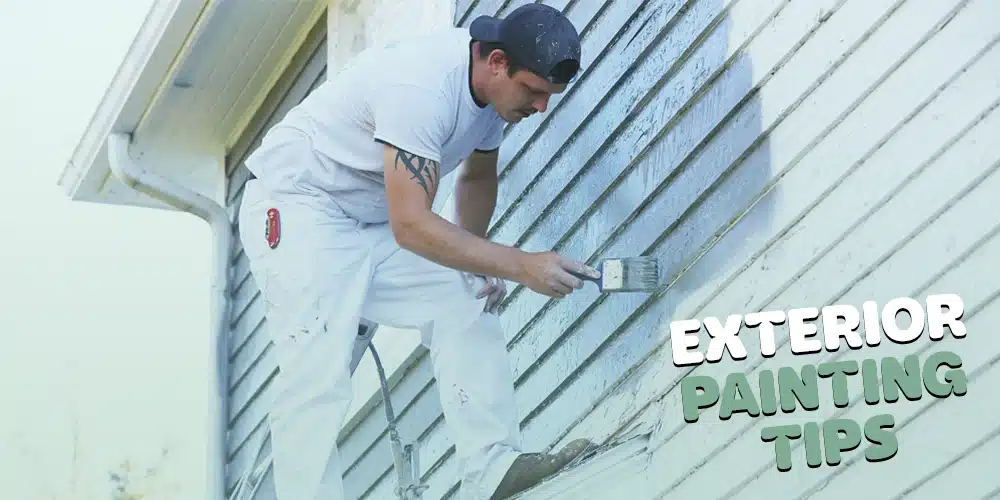When it comes to finishing wood, the biggest question people ask is: paint or stain? Wood may be strong on its own, but without the right finish, it’s at risk. Moisture, sunlight, & everyday wear can damage its surface, leaving it dull or even deteriorating over time. That’s why a protective coating is essential—not just for durability – but also for aesthetics !
You’ve got plenty of options while finishing wood like : varnish, lacquer, shellac, polyurethane, paint, and stain. But if you’re looking to enhance the wood’s appearance, paint and stain are the top choices.
Both can transform the look of wood, but they do it in very different ways. Paint sits on top, while stain soaks in. So, which one should you choose? This guide breaks down the key differences to help you decide what’s best for your project.
Let’s dive in!
What Is Paint & Types of Paint for Wood
Paint is a liquid coating applied to surfaces for protection and decoration. Once dry, it forms a solid, durable layer. It’s a top choice for wood finishes, shielding against moisture and wear while completely changing its look. Research from the Journal of Coatings Technology and Research shows painted wood lasts up to 50% longer than stained wood, especially in humid areas. Unlike stain, paint is always opaque, covering wood grain and offering endless color options. Whether you prefer bold or classic styles, paint provides the most design freedom. Let’s explore the three main types of wood paint.
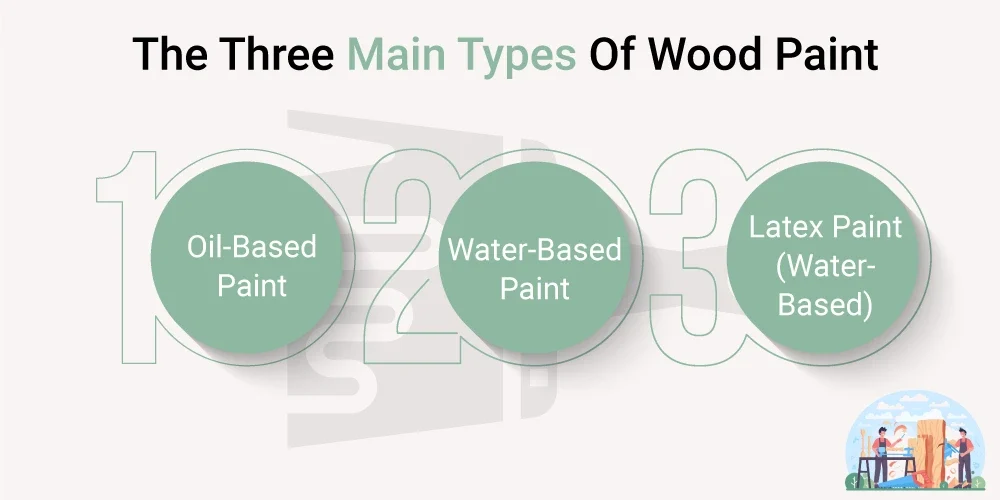
- Oil-Based Paint: A durable, glossy paint that provides a rich color and long-lasting finish.
- Finish & Look: Glossy, smooth, rich color
- Drying Time: Slow (12-24 hrs)
- Durability: High, lasts years
- Ease of Application: Requires primer & multiple coats
- Best For: Cabinets, furniture, outdoor surfaces
- Water-Based Paint: A quick-drying, versatile paint with a range of finishes from matte to semi-gloss.
- Finish & Look: Matte, satin, semi-gloss
- Drying Time: Fast (1-2 hrs)
- Durability: Medium, easier to touch up
- Ease of Application: Easy to apply & clean
- Best For: Walls, trim, indoor furniture
- Latex Paint (Water-Based): A flexible, fast-drying paint that resists cracking and doesn’t always need a primer.
- Finish & Look: Satin, eggshell, gloss
- Drying Time: Fast (1-2 hrs)
- Durability: Flexible, less cracking
- Ease of Application: Easy to apply, no primer needed
- Best For: Doors, baseboards, general projects
What Is Stain & Types of Stain for Wood
Stain, like paint, serves two key purposes:
1️⃣ Protects the wood from moisture and damage
2️⃣ Enhances the natural wood grain instead of covering it
Unlike paint, stain soaks into the wood rather than sitting on top, making it perfect
for showcasing natural textures. It comes in different opacity levels—you can choose a subtle tint that enhances the
grain or go for a more solid, paint-like finish.Research from Recent Developments Studies on Wood Protection Research in Academia highlights how stains, along
with other wood coatings, help protect surfaces while preserving their natural look.Let’s explore the three main
types of wood stain.
- Oil-Based Stain: A
deep-penetrating stain that enhances wood grain while providing long-lasting protection.- Finish & Look: Rich color, enhances wood grain
- Drying Time: Slow (12-24 hrs)
- Durability: Very high, deeply penetrates wood
- Ease of Application: Needs more prep, harder to clean
- Best For: Decks, fences, hardwood furniture
- Water-Based Stain: A
fast-drying stain that offers a natural wood look with lower VOCs and easier cleanup.- Finish & Look: Natural wood look, lighter color
- Drying Time: Fast (1-2 hrs)
- Durability: Medium, fades faster
- Ease of Application: Easy to apply, low VOC
- Best For: Interior woodwork, quick projects
- Gel-Based Stain: A thick,
easy-to-control stain that sits on the surface, ideal for even application on vertical surfaces.- Finish & Look: Thick consistency, even coat, no drips
- Drying Time: Medium (4-6 hrs)
- Durability: High, sits on top of wood
- Ease of Application: Easy to control, great for vertical surfaces
- Best For: Cabinets, doors, detailed woodwork
7 Key Differences b/w Paint & stain: Which Should You Choose?
Knowing the difference between stain and paint will help you make an informed decision that will leave you delighted with your newly decorated home or garden.
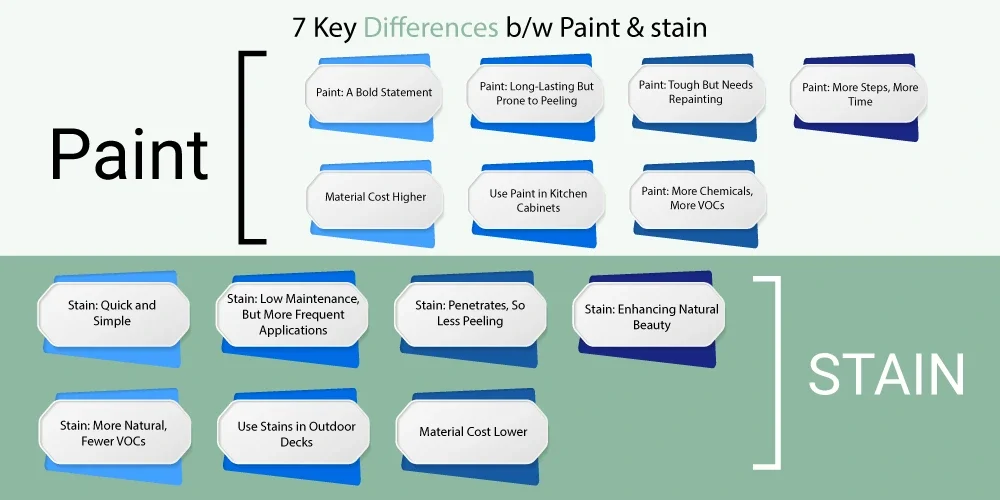
1. Coverage: Does It Hide or Highlight?
Paint: A Bold Statement | Stain: Enhancing Natural Beauty |
|
|
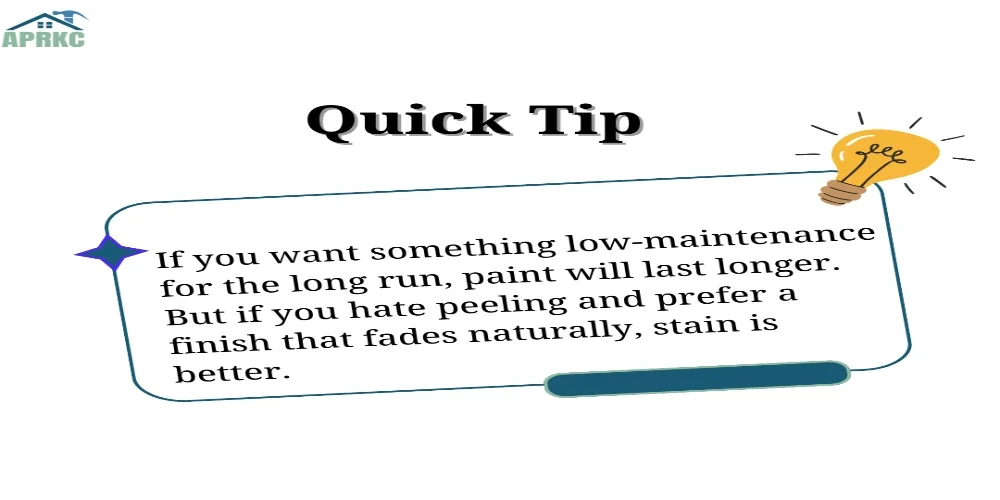
2. Durability: Which Lasts Longer?
Paint: Long-Lasting But Prone to Peeling | Stain: Penetrates, So Less Peeling |
|
|

3. Maintenance: Which Is Easier to Care For?
Paint: Tough But Needs Repainting | Stain: Low Maintenance, But More Frequent Applications |
|
|
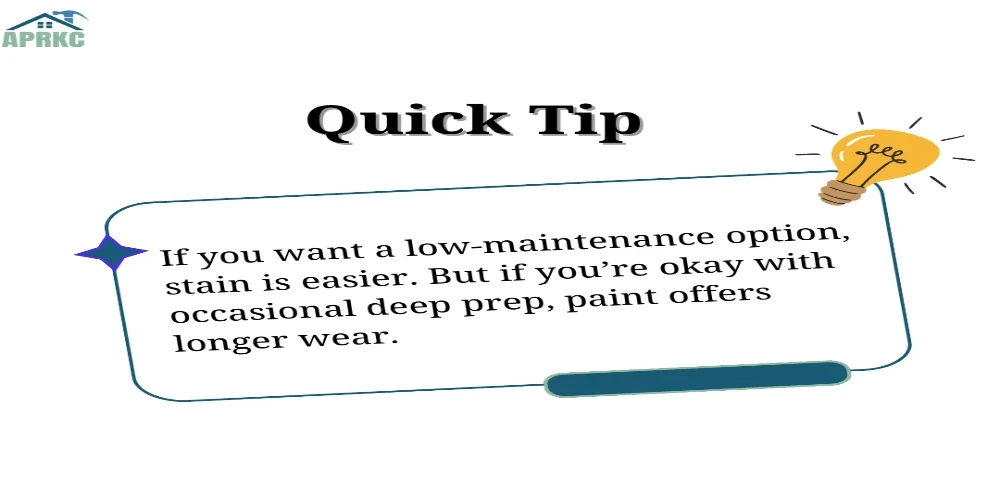
4. Application: Which Is Easier to Apply?
Paint: More Steps, More Time | Stain: Quick and Simple |
|
|

5. Cost: Which Is More Budget-Friendly?
Feature | Paint 💰 | Stain 💰 |
Material Cost | Higher | Lower |
Labor Cost | Higher | Lower |
Longevity | Longer | Shorter |
Reapplication | Less | More |
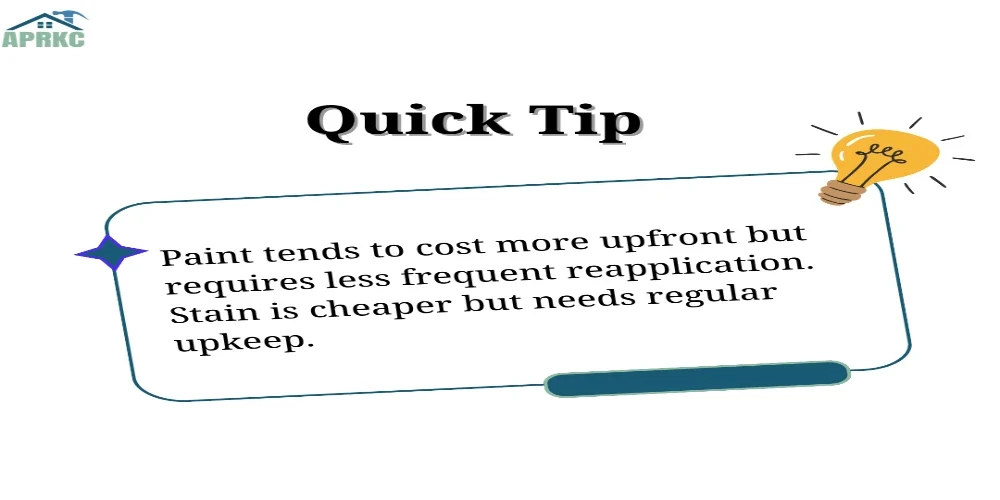
6. Where to Use Paint vs. Stain?
Surface | Best Choice |
Interior Walls | Paint 🎨 |
Kitchen Cabinets | Paint 🎨 |
Outdoor Decks | Stain 🌳 |
Wooden Fences | Stain 🌳 |
Furniture | Either 🎨🌳 |
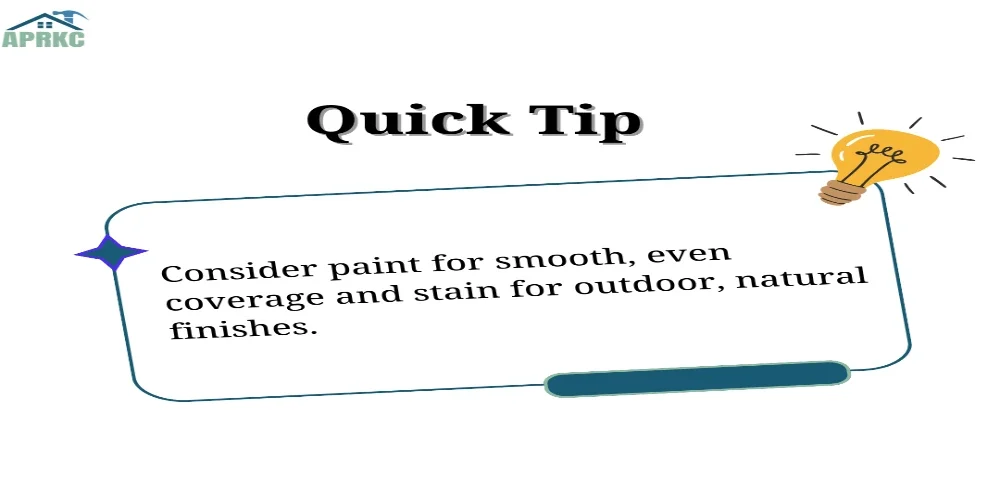
7. Environmental Impact: Which Is More Eco-Friendly?
Paint: More Chemicals, More VOCs | Stain: More Natural, Fewer VOCs |
|
|
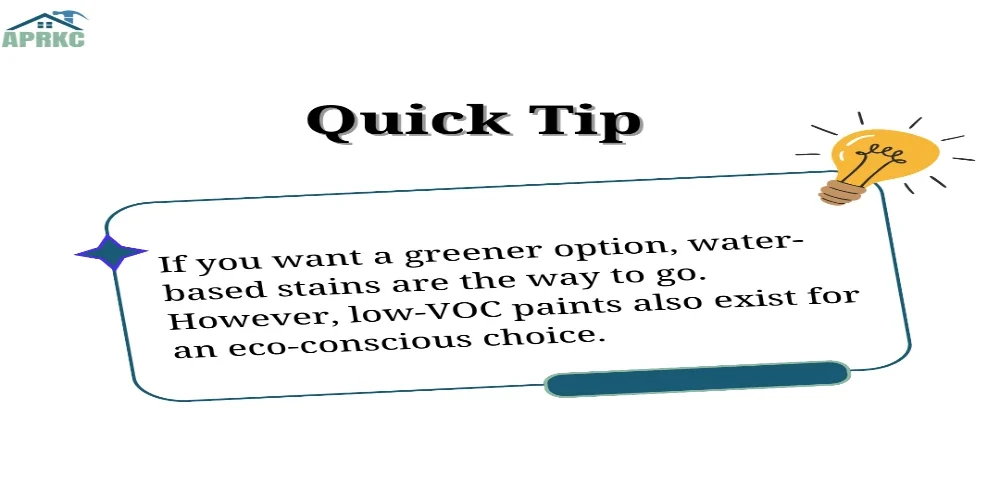
Paint vs. Stain: Pros & Cons
Both paint and stain have their advantages and drawbacks. The best choice depends on your project needs, durability expectations, and aesthetic preferences.
Pros of Paint
✅ More Color Options – Wide variety of shades and finishes.
✅ Long-Lasting – Can protect wood for 5–15 years with proper maintenance.
✅ Stronger Protection – Shields wood from moisture, UV rays, and rot.
Cons Of Paint
❌ Hides Wood Grain – Covers natural texture completely.
❌ Requires More Prep – Needs primer and multiple coats.
❌ Can Peel Over Time – Requires sanding and repainting for upkeep.
Pros Of Stain
✅ Enhances Natural Wood – Highlights wood grain instead of covering it.
✅ Easier Application – No primer needed, absorbs directly into wood.
✅ Less Peeling or Chipping – Wears away gradually instead of flaking off.
Cons Of stain
❌ Limited Color Choices – Mostly available in earthy, wood-toned hues.
❌ Shorter Lifespan – Needs reapplication every 2–5 years.
❌ Less Surface Protection – Doesn’t shield as effectively against harsh weather.
🎯 Which One Should You Choose? __ h3
Pick paint for vibrant color and long-term durability. Go with stain if you want a natural look with minimal maintenance.
Need Help Choosing the Right Finish? Let the Pros Handle It!
Still unsure whether paint or stain is the best choice for your project? No worries—we’ve got you covered! At Aaron’s Painting and Remodeling, we specialize in helping homeowners make the right decision based on durability, aesthetics, and maintenance needs.
Whether you’re refreshing your deck, upgrading your home’s exterior, or giving your cabinets a new look, our expert team ensures a flawless finish that lasts.
📞 Call us today at ((913) 730-3990) or visit aaronspaintingandremodeling.com to get a free consultation! Let’s bring your vision to life with the perfect finish.

